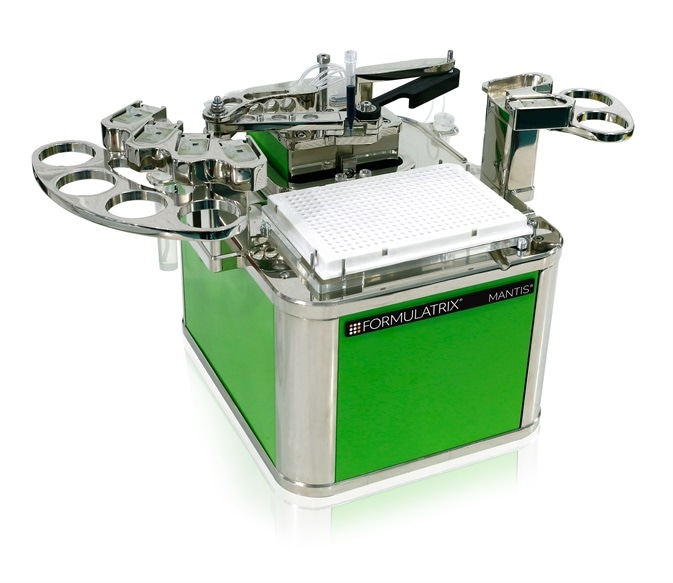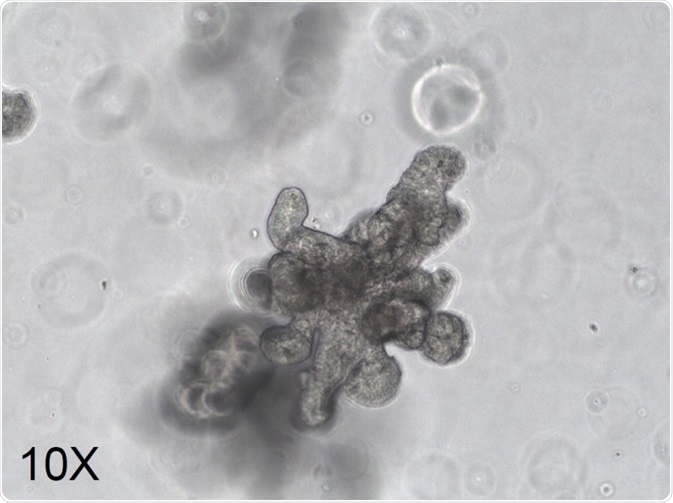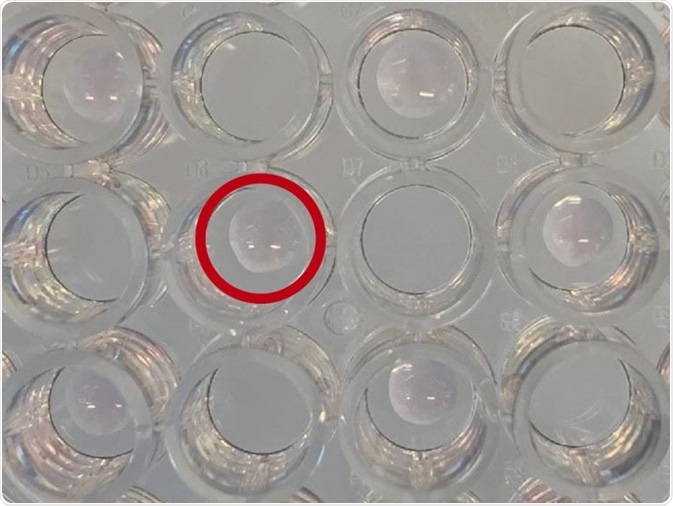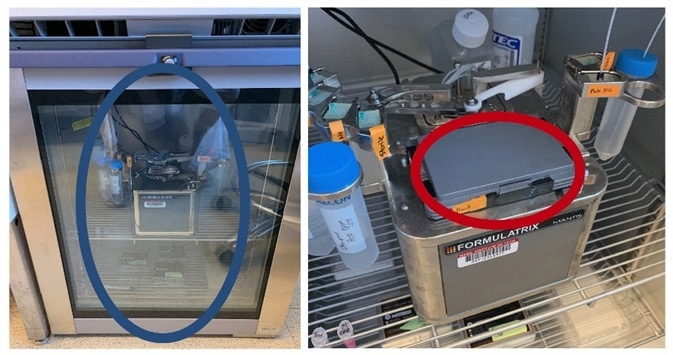Organoids enable researchers to examine tissue biology with remarkable fidelity. By supplying a three-dimensional in vitro culture system exhibiting key features of a specific organ, these complex, multicellular structures provide physiologically relevant insight to support numerous fields of research.
A major drawback of conventional organoid culture is that it is often a high-touch, labor-intensive process, needing highly specialized personnel to produce only moderate throughput.
Researchers at the Massachusetts Institute of Technology (MIT) within the Shalek laboratory were able to quickly screen >450 small molecules at a range of doses using the MANTIS® liquid handler from FORMULATRIX, for their capacity to enhance differentiation of Paneth cells within small intestinal organoids.
The MANTIS® was pivotal to advance understanding of multiple perturbations of limited sample material as it supplied a previously inaccessible level of throughput.
The epithelial barrier is a crucial therapeutic target
Tissue barriers formed by cells of the airways, skin, and gut supply interaction with, and protection from, the environment. They work closely with the immune system to supply defense against pathogens, functioning to balance nutrient, fluid, electrolyte and metabolic waste levels.
They also undertake a vital role in tumor surveillance and eradication. A broad spectrum of disease states implicates tissue barrier dysfunction. These include allergies, infections, cancers, and a number of autoimmune conditions.

The MANTIS® benchtop liquid handler. Image Credit: FORMULATRIX
Although therapeutics like antibiotics and antivirals can mitigate environmental exposure, and the immune response altered by utilizing immunotherapies and vaccines, in some cases existing methods are inadequate. The epithelial barrier has so far been underexploited as a therapeutic target despite being a key component of tissue barriers.
By utilizing organoid systems to model epithelial barrier tissue of different origins, researchers can better understand these complex systems to develop therapeutics which provide promising solutions to treat a large variety of conditions.
Organoid models are advancing research
In recent years, organoids are one of the most valuable advances in stem cell research. Organoids contain a population of stem cells with the capacity to differentiate into organ-specific cell types, whether they are derived from tissue samples containing adult stem cells, from single adult stem cells, or through directed differentiation of pluripotent stem cells.
Exhibiting similar function and spatial organization to the represented organ, these cells supply a physiologically relevant system that mimics in vivo conditions.

Figure 1. Organoids exhibit similar spatial organization and function to the represented organ, as exemplified by the crypt/villus morphology of this small intestinal organoid. Image Credit: FORMULATRIX
Organoid research has been limited by throughput
There are a variety of methods to grow organoids. These include culturing stem cells in the presence of a fibroblast feeder layer, or on a surface of controlled biomaterial substrates, yet the most popular technique is to encapsulate the stem cells within a biologically derived extracellular matrix (ECM) like Matrigel®.

Figure 2. Matrigel® domes encapsulate stem cells, supporting their proliferation to form physiologically relevant three-dimensional structures. Image Credit: FORMULATRIX
The cells proliferate to form three-dimensional structures representative of the organ of interest by surrounding the plated Matrigel® domes with a cell culture media containing defined growth factors.
Three specific requirements define organoid plating in Matrigel® domes:
- Accurate operation with very small volumes, as the sample material is usually extremely limiting.
- As Matrigel® and similar substrates exist as a viscous liquid at 4 oC, needing a warm surface and environment to form a solidified hydrogel, a reasonable degree of temperature control is required.
- Precise deposition of cell-laden ECM on to a pre-warmed tissue culture plate, avoiding the edges of the well to maintain the dome shape which is vital for maximal growth.
Miniaturization of organoid cultures to attain a scale compatible with conventional screening equipment (96/384/1536 well formats) is extremely challenging because of these requirements.
Although, by hand, the fairly trivial yet time-consuming process of Matrigel® deposition is achievable at 48-well plate scale, the rate of droplet mis-formation increases significantly at higher capacities and limits experimental reproducibility greatly.
The MANTIS® is a bench-scale solution to miniaturize organoid research
Researchers within the Shalek laboratory at MIT utilized the MANTIS® liquid handler from FORMULATRIX to dispense Matrigel® droplets into a variety of plate formats (up to 384 well) in order to overcome the limitations of manual Matrigel® deposition techniques.
The main aim of this study was to attain compound screening activities with small intestinal organoid systems at a scale amenable to high throughput methods.
The MANTIS® confines liquids to disposable chips to stop cross contamination. This also eliminates the requirement for washing by utilizing a single channel non-contact microfluidic dispenser to deliver individual reagents one well at a time.
Flexibility for multiple workflows is attained through the capacity to hold 6-48 chips and handle aqueous solutions up to 25cP (the equivalent of ~60% glycerol at room temperature) while precise volume delivery as low as 0.1 µL is backed by an industry-leading < 3% CV.
Further to these features, it can be easily contained within a temperature-controlled environment such as a refrigerator or incubator as the MANTIS® benefits from a small footprint of just 1 ft3. It is also compatible with a large scope of labware and instrumentation to provide seamless integration into existing workflows.

Figure 3. The MANTIS® has an exceptionally small footprint, allowing containment within a temperature-controlled environment. Here, the MANTIS® is sited within a refrigerator to allow Matrigel® plating at 4 oC on to a heated surface (grey = cold, red = warm). These conditions are ideal to form Matrigel® domes. Image Credit: FORMULATRIX
Miniaturizing small intestinal organoid culture delivers key insights
Ben Mead, a postdoctoral fellow within the Shalek laboratory at MIT and colleagues, screened a compound library in small intestinal organoid systems using the MANTIS® to miniaturize an existing workflow, to identify tool molecules that might enhance differentiation of Paneth cells.
These are the primary antimicrobial producing cells of the human small intestine and are critical for epithelial barrier function. After the application of a robust statistical measure to the data (yet to publish), Mead and colleagues discovered a number of hit compounds.
A number of these have since been entered into follow up studies, giving significant opportunity to delineate new biological targets to be considered in Paneth cell directed differentiation.
Increased scale enhances opportunities for personalized medicine
A number of the key features of the MANTIS® were key to the discoveries made by researchers at MIT. The MANTIS® provided precision plating over a number of plate formats by using a single free arm to dispense Matrigel® droplets, up to 384 well, to increase scale.
To extend throughput further, the instrument also has 1536 well capacity if required. The washable, disposable chip, fed from a pipette tip, enabled the MIT researchers to work with limited sample volume while decreasing reagent requirements and associated costs.
Furthermore, the small footprint of the MANTIS® meant that the entire unit was installed within a standard refrigerator easily, and combined with a pre-heated block to accurately deposit the chilled Matrigel® droplets on to a pre-warmed tissue culture surface (see figure 4); in comparison to manual techniques, this translated to significantly enhanced plating.

Figure 4. The MANTIS® significantly reduces reagent requirements including per well Matrigel® volume, plating media volume, and intestinal organoid seeding number, complementing these benefits with considerably shorter plating times. Image Credit: FORMULATRIX
MIT researchers have shown the miniaturization technique afforded by the MANTIS® to have proven utility in examining multiple perturbations of limited material. This has relevance to testing organoids derived from a single patient biopsy and opens up a number of new pathways for personalized medicine.
The incorporation of additional modes of measurement will improve model fidelity further still as technologies evolve and the MANTIS® is key to allowing the greater scale that these will demand.
About FORMULATRIX
FORMULATRIX® was established in 2002 to provide protein crystallization automation solutions. Since then, we've started developing other laboratory automation solutions including the next generation of liquid handlers using microfluidic technology.
Headquartered in Bedford, Massachusetts, we supply software and robotic automation solutions to leading pharmaceutical companies and academic research institutions around the world. Our team works tirelessly to provide the best products in the industry with support that is second to none.
Sponsored Content Policy: News-Medical.net publishes articles and related content that may be derived from sources where we have existing commercial relationships, provided such content adds value to the core editorial ethos of News-Medical.Net which is to educate and inform site visitors interested in medical research, science, medical devices and treatments.